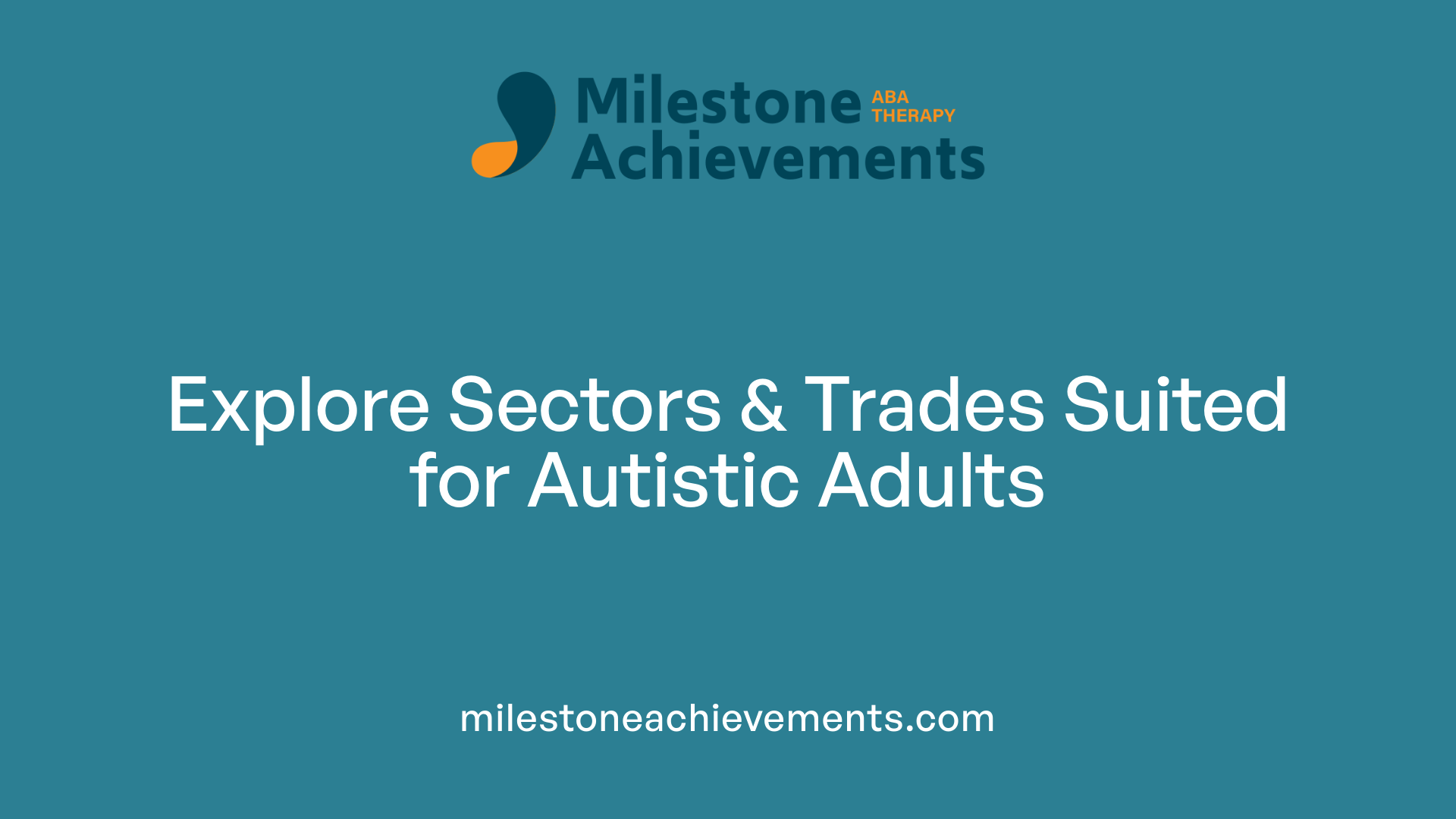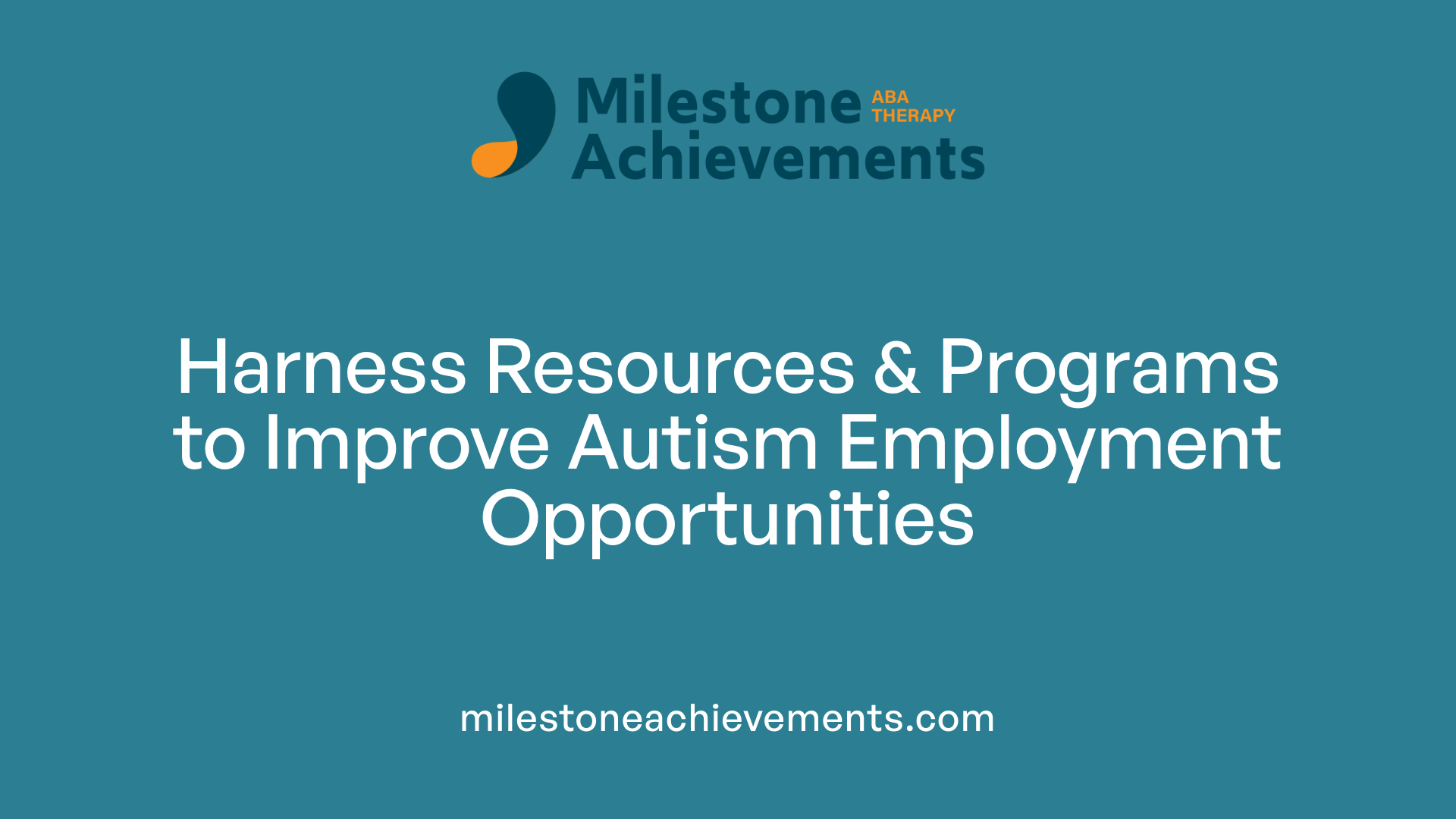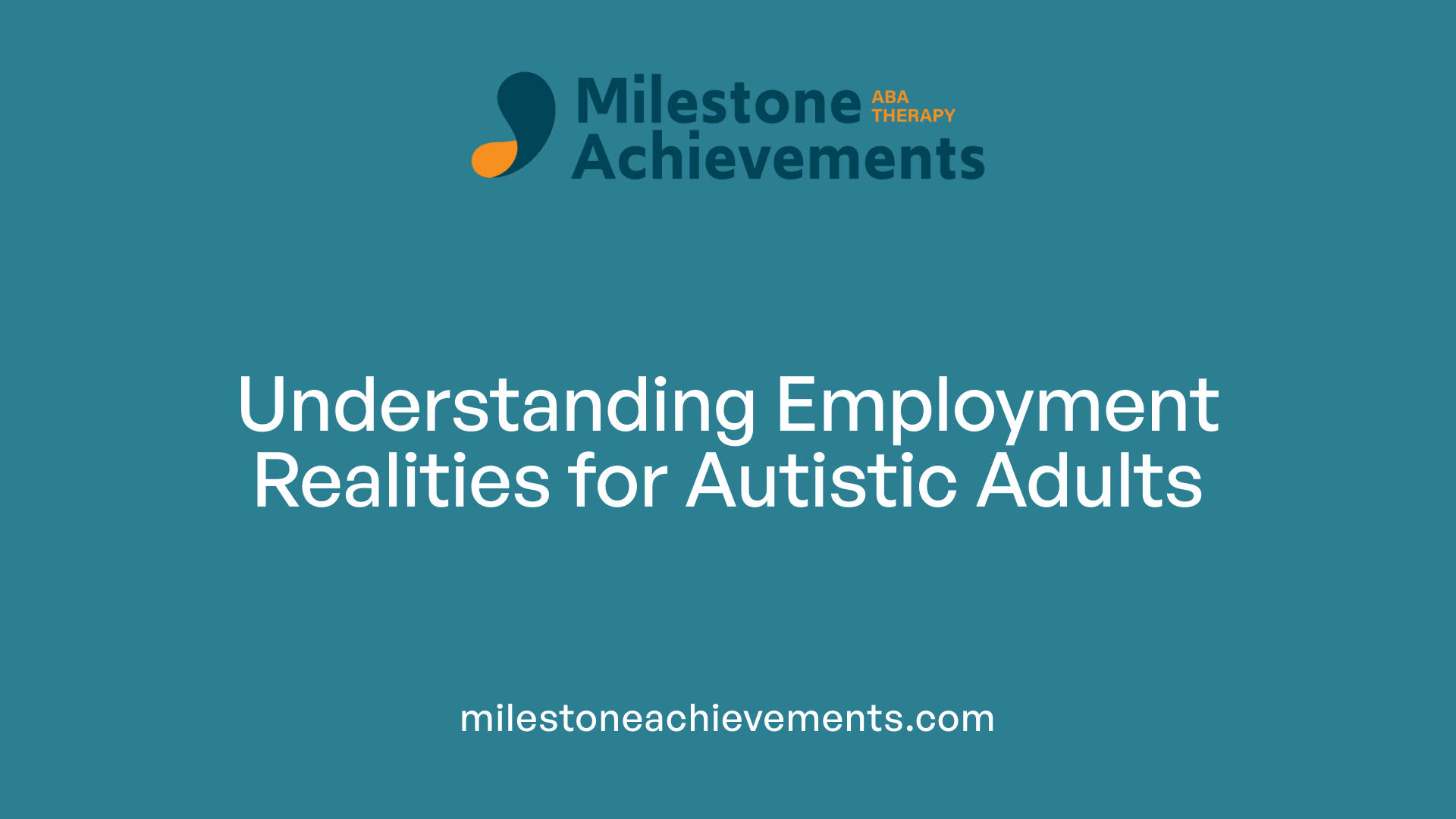
Unemployment Rates Among Autistic Adults
The Employment Gap for Autistic Adults: An In-depth Look
Understanding the Scope of Unemployment in the Autism Community
Autistic adults face significantly higher unemployment rates compared to their neurotypical counterparts, with estimates suggesting that up to 85% are unemployed worldwide. This article explores various factors contributing to these disparities, examines current employment statistics, and discusses resources aimed at improving employment outcomes for autistic individuals.
High Unemployment Rates and Global Perspectives

What is the unemployment rate for autistic adults?
Autistic adults worldwide face alarmingly high unemployment levels, a stark contrast to the general population. According to a 2021 study, around 40% of autistic adults in the United States are unemployed. Private estimates suggest that this figure could be as high as 85%, highlighting the pervasive employment gaps faced by this group.
In Europe, unemployment rates for autistic individuals have historically been high, with 76% to 90% unemployed in 2014. The situation remains severe in the UK, where 71% of autistic adults are unemployed. France shows an even more significant disparity, with only 1% to 10% of autistic adults in full-time employment.
Other regions mirror these struggles. In the Netherlands, a 2024 study found that autistic adults are more likely to work in sectors like healthcare, internet technology, and public services. Despite these opportunities, overall employment remains low, with an estimated 80% of autistic adults globally unemployed.
Comparison with other disability groups
When compared to other groups with disabilities, autistic adults often experience higher unemployment. For example, in the age group of 18 to 25, only 58% of autistic young adults have ever worked for pay. This rate is lower than 74% for those with intellectual disabilities and 95% for those with other learning disabilities.
Employment rates among young autistic adults are also lower than their peers with emotional disturbances or speech impairments. The employment rate increases with higher conversation skills and household income, yet overall, the employment gap persists.
Impact of societal attitudes and economic factors
Society’s perception of autism, coupled with barriers like stigma and inaccessible hiring practices, significantly contributes to these high unemployment rates. Many autistic candidates face challenges during interviews and in the workplace, often due to a lack of accommodations.
Economic factors further influence employment. For instance, in the US, only about 58% of young adults on the autism spectrum have ever worked during their early 20s, with earnings averaging less than minimum wage in some cases.
Efforts to improve employment outcomes include fostering inclusive work environments, offering workplace accommodations, and promoting awareness about the strengths of neurodivergent workers. Addressing societal stereotypes and enhancing support systems are crucial steps toward reducing the employment gap for autistic adults.
| Region | Autism Unemployment Rate | Notes |
|---|---|---|
| Worldwide | ~80% | Estimated globally |
| United States (2023) | ~85% | Private estimates |
| United Kingdom | 71% | Unemployment higher than other disabilities |
| France | 1-10% | Limited full-time employment |
| European Union (2014) | 76-90% | Historical data |
This data underscores the urgent need for inclusive policies and societal change to improve employment prospects for autistic adults across the globe.
Employment Outcomes and the Role of Education and Skills
What are the employment outcomes or statistics for autistic individuals?
Autistic adults face considerable challenges when it comes to employment. On a global scale, estimates suggest that as many as 80% of autistic adults are unemployed, which is a significant increase compared to other disability groups. In the United Kingdom, the unemployment rate exceeds 71%, and in France, less than 10% of autistic adults hold full-time jobs.
In the United States, recent data indicates that around 40% of autistic adults are unemployed, with estimates from private sources suggesting even higher figures, up to 85%. European data from 2014 show unemployment rates between 76% and 90%. These high rates reflect widespread barriers such as stigma, inaccessible hiring practices, and a lack of workplace accommodations. Despite employment benefits for mental health and overall well-being, many autistic individuals face structural and social obstacles that hinder their participation in the workforce.
How does education level influence employment prospects?
Education plays a vital role in employment outcomes for adults with autism. Research indicates that higher education levels significantly increase the likelihood of securing and maintaining employment. For instance, those with more advanced qualifications are more likely to find consistent work and less likely to be underemployed.
However, completing higher education can be challenging due to difficulties with social integration and higher learning environments, which may impede employment access. Despite these hurdles, improving educational support and post-secondary opportunities can help bridge the employment gap.
Why are conversation skills and early work experience important?
Communication skills profoundly impact employability among autistic adults. A study found that 90% of those with stronger conversation abilities were employed, versus only 15% of those with lower conversation skills. Early work experiences, such as holding jobs during high school, also positively influence future employment prospects. Those who worked during high school have up to a 90% chance of employment later on, compared to just 40% for those who did not.
Additionally, the type of work suited to neurodivergent strengths matters. Many autistic individuals excel in trade-related roles that require attention to detail and clear structure. For some, these jobs align better with their skills and preferences, resulting in higher job satisfaction and stability.
| Statistic | Percentage | Additional Details |
|---|---|---|
| Unemployment worldwide | 80% | High global rates of unemployment for autistic adults |
| UK employment rate (2017) | 32% | With only 16% in full-time roles |
| US employment (early 2020s) | 25% | Over 12-year longitudinal studies |
| Employment with early work experience | 90% | For those who worked in high school |
| Youth employment (aged 18-25) | 58% | Have ever worked; averages about three jobs |
Understanding these factors highlights the importance of targeted interventions, inclusive hiring practices, and support systems to improve employment access and stability for autistic adults.
Barriers and Challenges in Securing Employment
Why do many autistic adults struggle with employment?
Many autistic adults face significant challenges in finding and maintaining jobs. These difficulties stem from an array of factors, including sensory sensitivities that make noisy or chaotic environments overwhelming. Social communication challenges can also hinder workplace interactions, making it harder to establish relationships with colleagues or understand social cues.
The Double Empathy Problem explains how misunderstandings between autistic and non-autistic individuals are often mutual, leading to miscommunications that impact employment opportunities. Furthermore, many workplaces lack necessary accommodations, and societal misconceptions about autism frequently lead to discrimination during the hiring process.
Autistic individuals may struggle with adapting to traditional routines or environments that do not provide clear structure or predictability. This, combined with anxiety and the pressure to mask their traits to appear neurotypical, can make job retention difficult. As a result, many face higher unemployment rates, often exceeding 80% globally, with obstacles compounded by the absence of supportive workplace cultures.
Difficulties faced during hiring processes
Autistic candidates often encounter barriers during recruitment, such as stressful interview settings and unclear job expectations. These environments can be overwhelming, discouraging applicants from pursuing opportunities. Many employers are not yet equipped with inclusive hiring practices or understanding of autism, which hampers fair assessment.
Lack of accommodations and societal stigma
A major hurdle remains the lack of workplace accommodations tailored to autistic employees. Without adjustments—such as flexible schedules, quiet workspaces, or clear instructions—autistic workers may find it challenging to succeed.
Societal stigma and stereotypes about autism also play a role in limiting employment opportunities. Prejudice and misconceptions lead to discrimination, making it difficult for autistic adults to access equal employment rights or be seen for their skills.
Impact of sensory sensitivities and social communication Challenges
Sensory sensitivities can make typical office environments—bright lights, loud noises, and constant change—particularly stressful for autistic employees. Social communication difficulties can impede teamwork and networking efforts, which are often crucial for career advancement.
Despite these challenges, research shows that autism-friendly workplaces with proper accommodations and understanding can significantly improve employment outcomes for autistic adults. Emphasizing inclusive hiring and supportive work cultures reduces barriers and helps tap into the strengths of neurodivergent individuals, such as attention to detail and preference for routine.
The Impact of Disclosure and Workplace Support

What is the employment rate for autistic adults?
Recent studies show that employment rates among adults with autism vary widely depending on the region and access to support services. A specific study involving 254 adults with ASD found that about 61.42% were employed. Broader estimates, however, suggest a much lower overall employment rate; for example, around 20% of autistic adults are employed worldwide, with some estimates as low as 19.3%. In the UK and France, employment figures are considerably lower, with estimates indicating that only between 1% and 10% of autistic adults in France have full-time work.
Disclosing an autism diagnosis to employers can be a pivotal factor in improving employment outcomes. Data reveals that individuals who share their diagnosis are more than three times as likely to be employed compared to those who do not disclose. This suggests that openness, coupled with supportive workplace practices, can enhance job opportunities and stability.
Role of disclosing diagnosis to employers
Disclosing an autism diagnosis can be challenging, as many adults fear stigma or discrimination. However, when done strategically, disclosure can lead to better understanding and accommodation from employers. It opens the door for tailored support and adjustments that can make a significant difference in the employee's ability to succeed.
Employers who are aware of an employee's diagnosis can implement specific measures, such as flexible work schedules, quiet workspaces, or clarifying instructions, which align with the strengths and needs of autistic individuals.
Workplace accommodations and inclusive hiring practices
Supportive and inclusive workplaces are vital for improving employment retention among autistic adults. Organizations that adopt inclusive hiring practices—such as autism-friendly interview techniques and awareness training for staff—see better employment outcomes.
Workplace adjustments like clear communication, structured tasks, and accommodations for sensory sensitivities can reduce stress and boost productivity. A study published in 2024 highlighted that many autistic adults find manufacturing, trades, healthcare, and technology jobs particularly suitable because of their preference for routine and clarity.
How support can improve employment retention
Providing ongoing support and accommodations not only helps autistic employees gain employment but also retain their positions. Supportive cultures that promote understanding and flexibility contribute to higher job satisfaction and longer retention times.
Research indicates that support systems—such as mentorship programs, peer networks, and mental health resources—are associated with better employment stability.
| Aspect | Impact | Examples |
|---|---|---|
| Disclosure | Increases likelihood of employment | Sharing diagnosis helps tailor workplace supports |
| Accommodations | Enhances productivity and comfort | Flexible hours, quiet zones |
| Inclusive practices | Promotes fair hiring | Autism awareness training |
| Support networks | Improves long-term retention | Mentorship programs, peer groups |
Ultimately, fostering an environment of understanding, support, and flexibility is essential for boosting employment rates and creating sustainable careers for autistic adults.
Targeted Sectors and Skilled Trades Opportunities

Are there specific employment sectors suited for autistic adults?
Research indicates that certain fields are particularly well-suited for adults with autism. Many thrive in sectors such as healthcare, internet technology, military, and public or charity organizations. These fields often provide structured environments with clear rules, which align well with the preferences of autistic individuals.
Trade-skilled jobs are especially compatible with many neurodivergent strengths. Roles that demand attention to detail and precision are often a natural fit, as many autistic adults excel in areas that require meticulous work.
For example, manufacturing and trades are highlighted as good opportunities because they feature well-defined tasks and predictable routines. These sectors not only cater to specific neurodivergent strengths but also help mitigate stress associated with ambiguity that many neurotypical employees find challenging.
The availability of such jobs is notable. According to Leapros, a private staffing firm, there are approximately 388,000 vacant skilled trades positions that could be well-suited to autistic adults. Additionally, a report from Mentra: Neurodiversity Employment Network emphasizes that the structured, rule-based nature of these roles aligns with the preferences and abilities of many neurodivergent individuals.
This focus on targeted sectors offers promising pathways for improving employment rates among autistic adults, helping bridge the gap between potential and opportunity. Tailoring employment supports to these sectors can foster inclusive workplaces that leverage the unique strengths of neurodivergent employees.
| Sector | Employment Suitability | Relevant Strengths |
|---|---|---|
| Healthcare | High | Attention to detail, care, precision |
| Internet Technology | High | Logical thinking, problem-solving |
| Military | Moderate | Discipline, adherence to rules |
| Charity/Public organizations | Moderate | Empathy, structured routines |
| Manufacturing & Trades | High | Attention to detail, routine adherence |
This tailored approach not only benefits autistic workers but also enhances overall workplace diversity and productivity.
Resources and Support Programs for Employment

Are there resources or studies available on employment opportunities for autistic adults?
Yes, there are many organizations and programs dedicated to improving employment outcomes for adults with autism. Notable groups such as Autism Speaks, The Arc, and the Autism Society provide tailored support services including job training, placement assistance, and workplace accommodations.
Government initiatives also play a significant role. Agencies like the U.S. Department of Labor and the Office of Special Education and Rehabilitative Services offer resources on employment rights, reasonable accommodations, and transition programs tailored for autistic individuals.
In addition, specialized programs like Ticket to Work and the Autism Employment Connector Challenge aim to connect autistic job seekers with employers who commit to inclusive hiring practices. These programs promote vocational rehabilitation supports and encourage employers to adopt diverse and supportive workplaces.
Overall, the landscape of employment resources is designed to address barriers faced by autistic adults, such as difficulties during hiring processes, stigma, and lack of workplace support. Emphasizing inclusive practices, these initiatives are essential to bridging the employment gap and unlocking the potential of autistic individuals in the workforce.
| Organization/Program | Focus Area | Additional Details |
|---|---|---|
| Autism Speaks | Job training and placement | Provides resources for employers and job seekers, including employer guides |
| The Arc | Vocational services | Offers employment support, skill development, and advocacy |
| Autism Society | Awareness and resources | Shares comprehensive employment resources and host local initiatives |
| Ticket to Work | Federal employment program | Supports employment options for individuals receiving disability benefits |
| Autism Employment Connector Challenge | Employer engagement | Encourages inclusive hiring and provides networking opportunities |
This array of resources demonstrates ongoing efforts to improve employment prospects for autistic adults, supporting their integration into the workforce and enhancing their quality of life.
The Myth of Full-Time Employment and Concluding Insights

What percentage of autistic individuals have full-time jobs?
Data indicates that around 10-20% of autistic adults are employed in full-time positions, though this varies across regions and studies. For example, estimates suggest that only about 1-10% have full-time employment, with some reports indicating that approximately 24-25% find employment during their lifetime. Despite these low figures, ongoing efforts in policy change, workplace accommodations, and community support aim to improve these outcomes. Overall, increasing access to tailored employment programs remains essential.
The high unemployment rates among autistic adults are well-documented across various countries. In 2014, between 76% and 90% of autistic individuals in Europe were unemployed. More recent figures from 2021 in the United States show that approximately 40% of autistic adults are unemployed. Similarly, in the UK, about 71% of autistic adults are without employment. France reports even lower employment levels, with only 1-10% of autistic adults in full-time jobs.
Many adults with autism face barriers such as difficulties during hiring processes, stigma, and lack of workplace accommodations. The pressure to mask traits and challenges in completing higher education further hinder employment prospects. However, there are promising opportunities, especially in sectors like manufacturing, healthcare, and technology. Research reveals that individuals with autism often excel in roles requiring attention to detail and clear rules—skills well-suited for trade-related and technical jobs.
Inclusive employment policies and supportive workplace cultures can significantly impact these outcomes. Initiatives that promote diverse hiring practices and workplace accommodations are crucial. Encouragingly, studies suggest that raising awareness and providing targeted support can increase employment rates. Community-driven programs and government policies dedicated to neurodiverse employment are steps toward reducing unemployment and enhancing quality of life for autistic individuals.
| Employment Figures | Region/Population | Estimated Percentage | Additional Notes |
|---|---|---|---|
| Unemployed autistic adults | Worldwide | 80% | Approximate global estimate |
| Full-time employment | France | 1-10% | Based on regional estimates |
| Employment rate (UK, 2017) | UK | 32% | Overall, with 16% in full-time work |
| Lifetime employment | General | 24-25% | Long-term employment prospects |
| Autistic adults working part-time | US | Nearly 80% of working sample | Hourly wages average $9.11 |
| Autism employment estimates | US (2023) | 15-25% | Various sources including longitudinal studies |
Understanding these figures highlights the ongoing challenge but also the potential for growth. Tailored employment programs, workplace support, and inclusive policies are vital to improving employment rates among autistic adults.
Moving Toward Inclusive Employment Practices
Addressing the high unemployment rates among autistic adults requires a multifaceted approach encompassing better education, tailored workplace support, inclusive hiring practices, and societal awareness. Developing sector-specific opportunities, especially in fields aligned with autistic strengths like detail-oriented trades and technology sectors, can lead to more meaningful employment. Strengthening community resources and advocating for policies that promote workplace accommodations will be pivotal in closing the employment gap for autistic individuals, ultimately improving their quality of life and societal integration.
References
- Predictors of employment status among adults with Autism Spectrum ...
- People with autism often have difficulty finding employment. This ...
- Employment of autistic people - Wikipedia
- NDEAM Highlights Barriers and Progress To Employment
- [PDF] Employment Outcomes of Young Adults on the Autism Spectrum
- Access to employment: A comparison of autistic, neurodivergent and ...
- Autism and the Workforce | Psychology Today
- Autism and Employment Challenges: The Double Empathy Problem ...
- Autism and Employment - Child Mind Institute


Partner with us on your child's journey
Milestone Achievements offers evidence-based ABA therapy to help children with autism reach their full potential. Together we’ll set meaningful goals and celebrate progress every step of the way.
Start ABA Services Today


